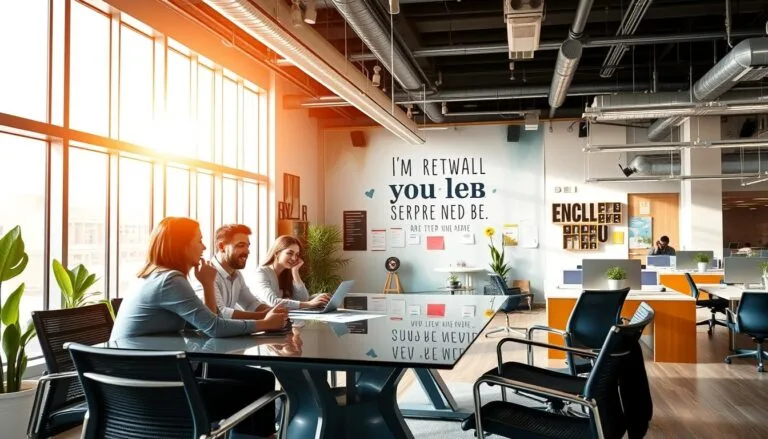Reactive Decision-Making Style A Behavioral Analysis

In today’s fast world, reactive decision-making is key in business. It’s about making fast choices when problems pop up. Even with plans in place, surprises can force us to act quickly.
Those who make reactive decisions trust their gut feelings. This is common in places where speed is everything. But, it’s important to remember that these quick choices might not always be the best in the long run.
Key Takeaways
- Reactive Decision-Making Style is vital for unexpected crises and quick choices.
- Intuitive reasoning and instinctive responses are key in reactive decision-making.
- While reactive decisions solve immediate problems, they might not be the best long-term.
- Having plans and backup strategies can reduce the need for quick decisions.
- It’s important to balance quick and planned decisions for success.
Understanding Reactive Decision-Making
Reactive decision-making is how we handle sudden changes or emergencies. It’s about making quick decisions based on what we know and feel. This approach is fast but might not be as thorough as planning ahead.
Definition and Overview
Reactive decision-making means acting fast in response to sudden events. People use their instincts and past experiences to guide them. They focus on acting quickly, even if it’s not always the best plan.
- Rapid assessment of the situation
- Reliance on past experiences and intuition
- Limited time for gathering and analyzing information
- Focus on short-term solutions
Importance in Behavioral Studies
Studying reactive decision-making is key in behavioral studies. It shows how we react under pressure. People who make reactive decisions often solve problems well, thanks to their experience.
Reactive individuals generally demonstrate high levels of ownership and comfort with uncertainty, acting without exhaustive planning.
Behavioral scientists study what affects reactive decision-making. They look at biases, emotions, and the environment. This helps them find ways to improve decision-making in tough situations. This knowledge is useful in many areas, like emergency teams and business leaders.
Characteristics of Reactive Decision-Makers
Reactive decision-makers make quick, impulsive choices without fully thinking them through. Their decisions are often driven by strong emotions like fear or excitement. While quick decisions can be good in some cases, relying too much on them can lead to poor outcomes.
Quick Responses and Impulsive Choices
Reactive decision-makers are known for their fast, instinctive choices. They act on their first thoughts or feelings without fully analyzing the situation. This impulsive behavior can be due to time pressure, stress, or lack of confidence in their decision-making.
Research shows that the reactive decision-making style is better than being inactive but not the best.
Emotional Influence on Decisions
Emotions greatly influence the decisions of reactive individuals. They often let their feelings guide their choices, not logic or data. This can lead to biased judgments and choices that don’t match their long-term goals or values.
As a result, reactive decision-makers may feel overwhelmed and frustrated when they see the consequences of their choices.
“Reactive decision-making can result in poor or hasty decisions due to a lack of information or analysis.”
In contrast, proactive decision-making is seen as the most effective. It involves wise and strategic thinking. Proactive decision-makers take time to gather information, analyze outcomes, and consider different perspectives.
This approach leads to better choices and results. Using early warning strategies and scenario planning can help shift from a reactive to a proactive mindset. This reduces stress, saves time and resources, and boosts creativity.
The Psychology Behind Reactive Decision-Making
Reactive decision-making is a complex process. It involves many psychological factors. When we face high-pressure situations or tight deadlines, we often make quick, intuitive judgments. This can lead to biased and suboptimal decisions.
Neuropsychology research shows our brain uses two systems for decision-making. The prefrontal cortex handles the reflective system, while the basal ganglia and amygdala handle the reactive system. The brain can only use one system at a time. So, when stressed, we rely on the reactive system.
Cognitive Biases at Play
Cognitive biases, like the availability heuristic and confirmation bias, affect reactive decision-making. The availability heuristic makes us judge based on what’s easily available in our minds. Confirmation bias makes us seek information that confirms our beliefs.
These biases can lead to poor decisions, even in Real-Time Problem-Solving. In crises or tight deadlines, we might rely on our gut and past experiences. This can result in decisions based on incomplete or inaccurate data, leading to unintended consequences.
The Role of Stress and Pressure
Stress and pressure significantly impact reactive decision-making. Stress releases hormones like cortisol and adrenaline, affecting our thinking. These hormones can make us act impulsively and emotionally.
“The human brain is a complex and fascinating organ that plays a critical role in decision-making. By understanding the psychological factors that influence our choices, we can develop strategies to make better decisions, even in high-pressure situations.”
To improve decision-making under stress, we need emotional intelligence and self-regulation. Emotional intelligence helps us manage our emotions and understand others’. Self-regulation helps us control our impulses and behaviors, even in tough situations.
By developing emotional intelligence and self-regulation, we can make better decisions, even in uncertain situations. This means taking a step back, assessing the situation objectively, and considering multiple perspectives. It also means being open to adapting our approach as new information comes in.
Situational Triggers for Reactive Response
In today’s fast world, we often make quick decisions based on what’s around us. These decisions can be influenced by many things, inside and outside of us. Knowing what triggers these reactions is key to making better choices.
Things like tight deadlines and what others think can push us to act fast. This can lead to choices we might later regret. A study showed that quick decisions can make conversations turn bad, but careful choices can help solve problems together.
Environmental Cues
Our surroundings greatly affect how we react and decide. Some cues can make us act without thinking. For example, a family dinner can turn into an argument if we react too quickly. But, choosing wisely can make the moment better and strengthen bonds.
Internal vs. External Motivators
It’s not just outside factors that guide our choices. Our own values, feelings, and past experiences also play a big part. A leader found that quick reactions hurt team confidence and limited new ideas. But, choosing carefully can bring everyone together and spark creativity.
“Between stimulus and response there is a space. In that space is our power to choose our response. In our response lies our growth and our freedom.” – Viktor E. Frankl
By being aware of what triggers our reactions, we can make better choices. Mindfulness, controlling our emotions, listening well, and showing empathy are ways to improve our decision-making. These steps help us move towards making choices that reflect our true goals and values.
Comparing Reactive and Proactive Decision-Making
People and companies often choose between reactive or proactive decision-making. Reactive decision-making deals with problems as they come up. Proactive decision-making looks ahead and plans to avoid or lessen future issues. Proactive managers plan ahead to anticipate challenges, ensuring they are prepared for potential trends and risks.
Proactive decision-making looks ahead and plans to avoid or lessen future issues. Anticipating challenges is a key part of this approach, as it helps to avoid problems and seize new opportunities.
Key Differences in Approaches
Reactive managers focus on solving immediate problems. They don’t plan for the long term, which can make it hard for a company to adapt. In contrast, proactive managers plan ahead, use data analysis to guide their decisions, and set long-term goals. Proactive managers aim to enhance operational efficiency through strategic planning.
Benefits and Drawbacks of Each Style
Reactive decision-making is good for quick crisis management and sparking new ideas. But, it can leave leaders unprepared for surprises. Proactive decision-making helps avoid problems, saves time and money, encourages innovation, and develops future strategies. Proactive decision-making uses data analytics to inform future strategies.
Mixing both reactive and proactive styles can make leaders more effective. Tools like the Eisenhower Matrix help organize tasks by urgency and importance. To lead proactively, one needs coaching, self-awareness, and good time management. Using technology and data can also help, like smart energy systems for better energy use and IoT for predictive maintenance.
Case Studies of Reactive Decision-Making
Reactive decision-making is common in business and politics. It means making quick choices based on what’s happening right now. This approach can be good in some cases but might also cause problems.
Examples in Business Contexts
In business, quick decisions are often needed to handle urgent problems. A study from the Harvard Business Review highlights the effectiveness of proactive decision-making. For example, a company might have to act fast during a product recall. This helps protect its reputation and money.
But, relying too much on quick decisions isn’t always best. Proactive management, which includes listening and planning, can help avoid big problems. It leads to better choices.
Notable Public Figures and Their Decisions
Politicians and CEOs are watched closely for their decisions, even in tough times. Their choices can affect their careers and the people they serve.
“In any moment of decision, the best thing you can do is the right thing, the next best thing is the wrong thing, and the worst thing you can do is nothing.” – Theodore Roosevelt
Studies show that decision-making can be emotional or thoughtful. Personality traits like openness or neuroticism can also play a role. Knowing this, leaders can aim for better choices, even when it’s hard.
Implications of Reactive Decision-Making
Reactive decision-making can harm personal relationships and work culture. Making impulsive choices without thinking ahead can cause conflict and mistrust. It can also damage relationships.
In the workplace, a culture that values quick decisions can be stressful. Employees might feel forced to act fast without fully thinking it through. This can slow down innovation and lower performance, as they focus on solving immediate problems instead of planning ahead.
Impact on Personal Relationships
Impulsive choices in personal relationships can hurt trust and cause tension. Partners, friends, and family might feel ignored, leading to frustration and resentment. This can weaken even the strongest relationships over time.
“The greatest damage to relationships comes from reactive decision-making, where emotions overpower reason.” – Dr. John Gottman
To keep relationships healthy, it’s key to be mindful and think about the effects of our actions. This helps avoid acting on impulse.
Effects on Organizational Culture
In companies, a culture that values quick decisions can have big problems. Employees under pressure to act fast without enough info can feel stressed and unhappy. This can lead to less engagement and creativity.
Increased stress levels
Decreased job satisfaction
Lower employee engagement
Reduced innovation and creativity
Also, a reactive approach can mean missing out on chances and not getting the best results. Employees might focus on short-term fixes instead of long-term plans. Leaders should aim for a balance between quick and thoughtful decisions, leading to informed decision making. Leveraging data analytics helps in making informed decisions. They should give employees the tools and support to make smart choices.
Strategies for Managing Reactive Decisions
In today’s fast-paced business world, reacting quickly is often necessary. Companies must keep up with market trends, competitor actions, and new rules. But always reacting can lead to poor choices and missed chances.
To tackle these challenges, businesses can use several strategies. One important method is to enhance operational efficiency as a key strategy. Optimizing resource allocation is crucial for better decision-making. Another method is to learn emotional control techniques. Deep breathing and mindfulness help reduce impulsive decisions. This way, even under pressure, choices can be more thoughtful and careful.
Techniques for Emotional Regulation
Controlling emotions is key in managing reactive decisions. When crises or surprises happen, emotions can get the better of us. But, by using deep breathing, meditation, and positive self-talk, we can manage our feelings better.
“In the midst of chaos, there is also opportunity.” – Sun Tzu
Developing Reflective Practices
Another vital strategy is to practice reflection after making decisions. Taking time to review and improve can offer insights and help in better resource allocation. Strategic planning is essential for effective decision-making. Getting feedback from others can also reveal new perspectives and mistakes. Regular reflection helps in making better choices in the future.
A LinkedIn survey found 426 contributions on reactive decision-making. This shows the value of sharing and learning from others. By always learning and being open to new ideas, businesses can improve their decision-making skills.
The Role of Technology in Reactive Decision-Making
In today’s fast world, technology is key in making quick decisions. Businesses face many challenges and technology helps them solve problems fast.
Social media is a big player in quick decision-making. It spreads news fast, making it urgent for leaders to act quickly. This helps companies stay on top of issues and keep their image strong.
Influence of Social Media
Social media is very important in handling crises. If there’s a problem, social media can make it worse fast. Leaders need to watch social media closely to make good choices quickly.
Decision Support Systems
Companies use AI and data tools to make better decisions. These tools look at data to suggest what to do next. They use advanced math to guess what might happen and help make decisions.
These systems help companies use data to make smart choices. They look at past and current data to find trends and solve problems fast. As technology gets better, these systems will help companies deal with challenges even faster.
Future Trends in Decision-Making Styles
The world is getting more complex and fast. Decision-making styles are changing to keep up. Companies now see the value in balancing planning and solving problems quickly.
By understanding these trends, businesses can prepare for the future. This helps them stay ahead in a changing world.
Emerging Research on Behavioral Patterns
Studies have shown how people make decisions. Over a third of CEOs like to react quickly, not plan ahead. But, companies with proactive leaders grow more.
Proactive entrepreneurs are good at communicating and solving problems. Reactive leaders are quick to adapt and solve problems fast. Finding the right mix is key.
Shifts in Organizational Strategies
Companies are becoming more agile and adaptable. A proactive approach is 25% more productive. Investing in proactive strategies boosts efficiency and supports sustainable growth.
But, reactive decisions have their place too. They offer quick fixes but might miss bigger opportunities. A mix of both strategies keeps companies flexible and strategic.
As companies adapt, tools like Fingerprint for Success help understand leadership. AI coaching helps improve decision-making. This leads to better outcomes and happier stakeholders.
Conclusion: The Importance of Understanding Decision-Making Styles
In today’s fast world, knowing how to make decisions is key. It’s important for both people and companies. By understanding the difference between reactive and proactive decision-making, we can learn to make better choices.
Final Thoughts on Reactive vs. Proactive
Reactive Decision-Making Style is quick but often based on emotions. This can lead to choices that don’t help in the long run. Proactive decision-making, on the other hand, is more thoughtful and planned.
While quick decisions are sometimes needed, finding a balance is important. This balance helps us achieve better results.
Knowing how reactive decision-making works helps us control our emotions. Companies can also improve by supporting balanced decision-making. Technology can help us make better choices, but we must be careful of its influence.
Success comes from knowing the good and bad of each decision style. By finding a balance, we can make choices that help us grow and succeed in a complex world.
















